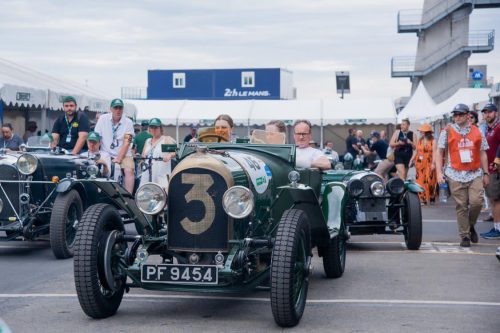
The classic Le Mans race took place at the Sarthe circuit from 3 to 6 July. More than 800 cars took part in the event. One of the participants in the race were the Getley sisters. About the preparation, the difficulties of driving a pre-war car and the generational change are in an interview with AutoClassicNews.
-Do you have a training program for Le Mans? What is it like?
-We haven’t had a particular training program for Le Mans, we have just been building on our racing skills by practicing in the Mx5’s Miata Trophy and through lots of driver tuition from Lewis Fox. We had not had much practice driving the 3-litre at all. In total, I think we had both only driven it for about half an hour each before the Le Mans qualifying. A huge amount of prep went into getting the engines ready by Kingsbury Racing Shop, and so that was the main priority before the weekend. We were just happy to be there and having the opportunity to go around the track at full speed!
-Is there anything special you do to the car to prepare it?
-Kingsbury Racing Shop were behind all the prep for the car. They all spent a huge amount of time getting the engine built and the car racing-ready in the weeks leading up to Le Mans, alongside two other Bentleys also competing in the same race. Luckily for us, once the car reached France, she was fully prepped and ready to race. All we needed to do to load her up with some extra fuel and she was ready to go steaming around the Le Mans track! Aside from this, Simon (from the Kingsbury Engine Shop) strapped a small plastic model of the car to the front, where the ballast would have been placed in the Bentley days, for a bit of extra luck!
-What part is the hardest in Le Mans race?
-The hardest part of the competition came during the last race. Once we were back up and ready to tackle the 10am race, following a night of very little sleep, we set off in the pouring rain. We both have had very limited experience racing in the rain, with Louisa’s only experience leading to a spin in the 3/ 4.5 Bentley at Silverstone. Once the race had begun, it then became very apparent that there was a large volume of oil also dropped along the extent of the Le Mans track (all 8.5 miles of it). This led to an even more treacherous run as we had to dodge between oil, puddles, and wet painted curbs. Luckily, the 3-litre was just the car for the job as it is much lighter than the other Bentleys. We both came away having had a lot of fun sliding around the track and managed to keep our position through it all as well.
-How would you describe race driver’s day in Le Mans?
-Over the 24 hours of racing, both the day and night were filled with excitement, chaos, and lots of very lovely cars. Each race came with new excitement as we had day, night, wet, and dry racing throughout. Having qualified fairly far down the starting grid, after Anna had to fix the throttle linkage with a transponder pin on track and subsequent yellow flags, we spent a lot of the races trying to catch up places, eventually making up 23 from our starting position. Challenges came when we were battling adrenaline with serious sleep deprivation, but it was all part of the experience and we had our lovely pit crew to keep us entertained throughout those hours. Coming out to crowds of 280,000 people was absolutely mind-blowing and made us feel like a celebritries! We had some really lovely chats with people who admired the cars and the fact two young women were driving them — it really was the people and the atmosphere that made the Le Mans Classic.
-Are you happy with the current sports regulations? Is there anything you would like to change?
-I think so far, so good with the sports regulations we have come across. We recognise the incredible work the marshalls do in keeping everyone safe on track and the regulations are in place to make racing as much fun as possible, whilst minimising risk where they can. The difficulty in vintage racing comes with making it a more even playing field, as all the cars are built to such different standards — for example, it is more difficult for us to keep up with a Blower whilst in a 3-litre. However, the Le Mans Classic did a great job at ensuring all cars were authentic to their period and from that we can’t complain! We were all just there to have fun.
-What may be a reason for new generation to enter the race? How may we win Gen Z over?
-The best way for the next generation to be as enthusiastic about racing vintage cars as we are is to just have a go and see for themselves just how much fun it is! I think they can be underestimated, as many people believe they don’t go as fast as modern cars, but when you’re blasting down the Mulsanne straight at over 100mph, with the wind in your face and no seat belt to hold you in, there really is no other feeling like it. We are always trying to encourage younger people to get involved and are always open to a chat with anyone who might need some encouragement!